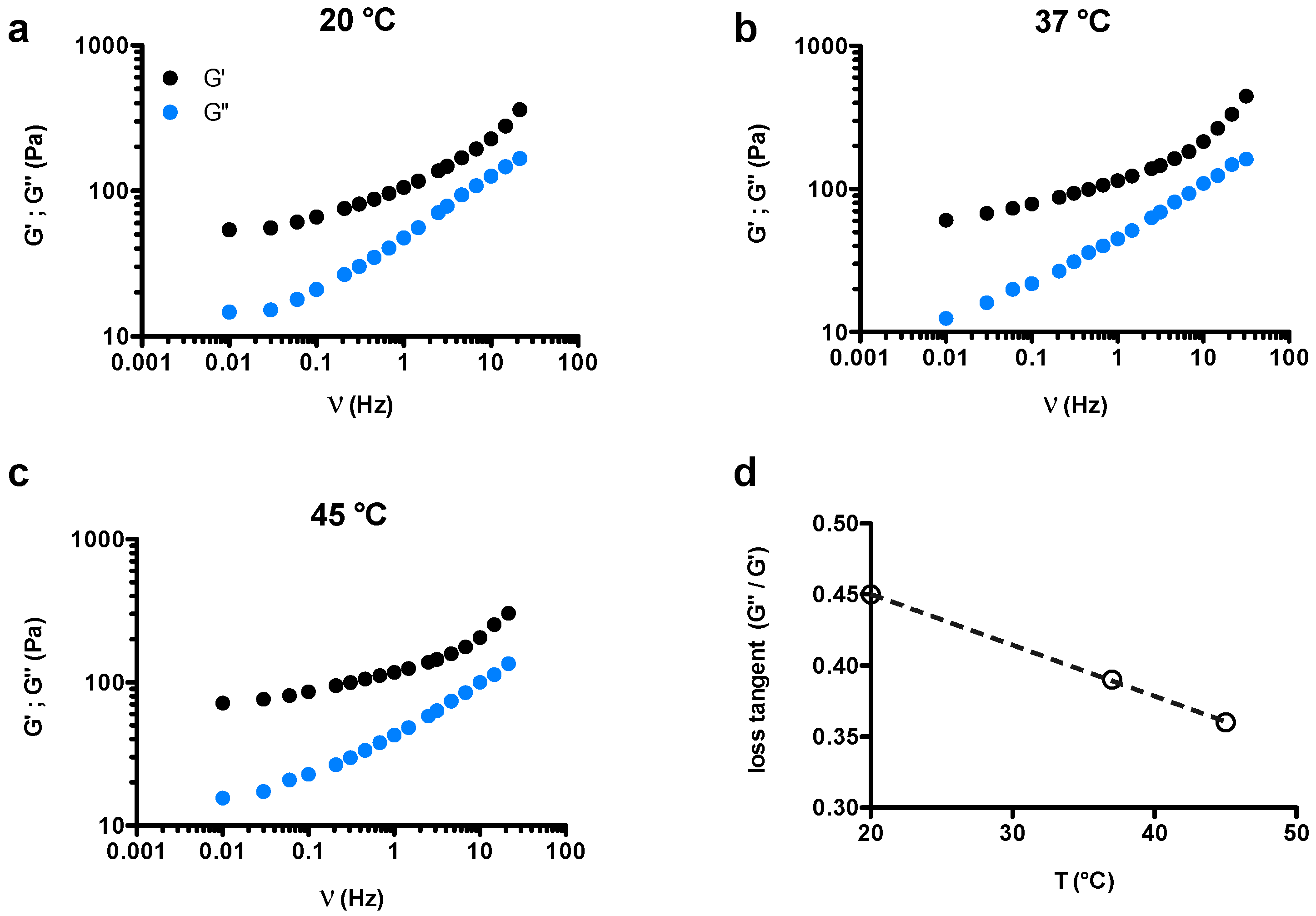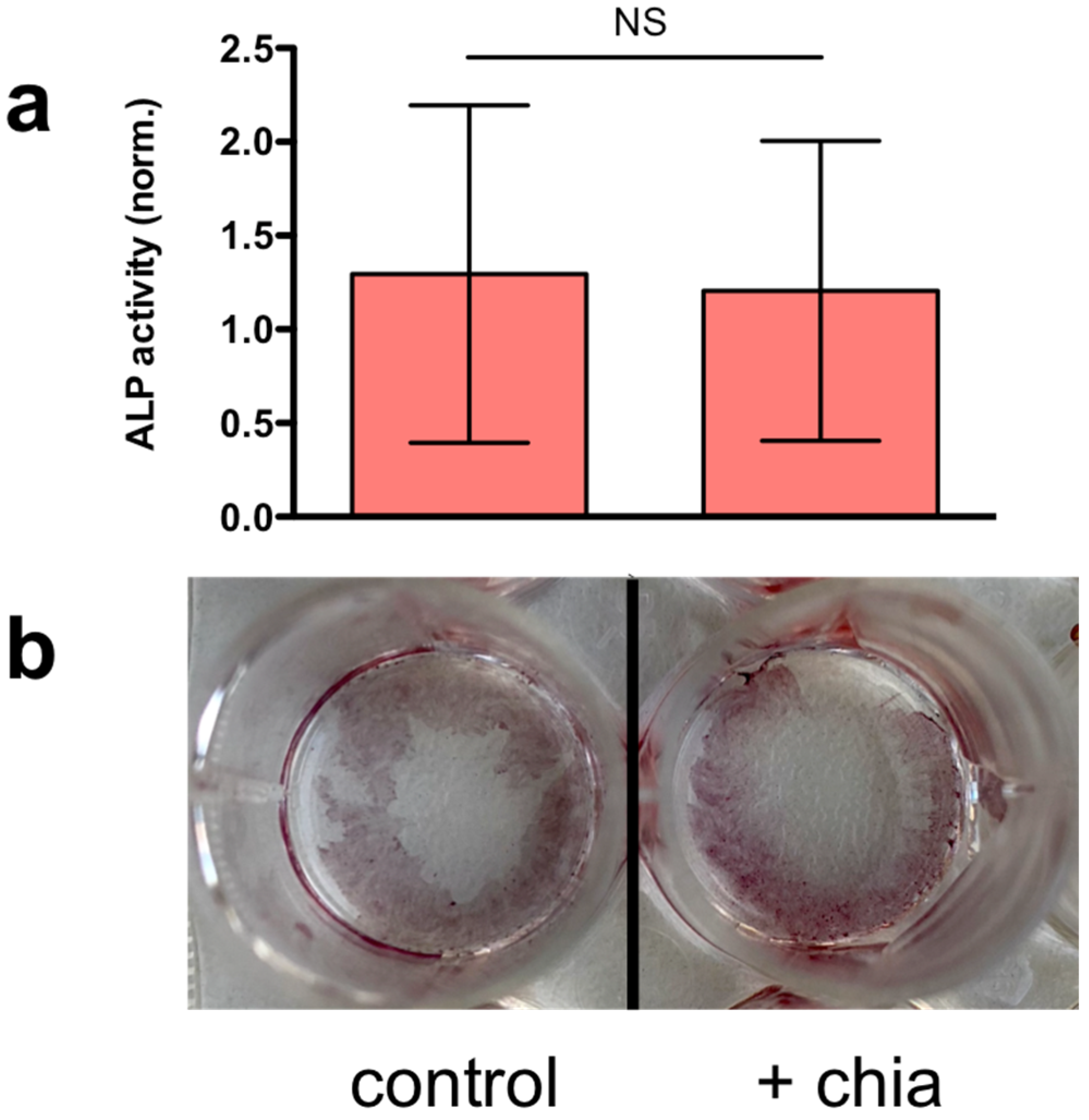Insights into Mechanical Behavior and Biological Properties of Chia Seed Mucilage Hydrogels
Abstract
1. Introduction
2. Results and Discussion
2.1. Mechanical Behavior
2.2. Biological Properties
3. Conclusions
4. Materials and Methods
4.1. Materials
4.2. Mucilage Extraction from Chia Seeds
4.3. Hydrogel Preparation
4.4. Mechanical Analysis
4.5. Cell Culture Preparation for In Vitro Tests
4.6. Evaluation of Cytotoxicity: Lactate Dehydrogenase (LDH) Assay
4.7. Analysis of Stem Cell Differentiation
4.8. Alizarin Red S Staining
Author Contributions
Funding
Institutional Review Board Statement
Informed Consent Statement
Data Availability Statement
Conflicts of Interest
References
- Cok, M.; Sacco, P.; Porrelli, D.; Travan, A.; Borgogna, M.; Marsich, E.; Paoletti, S.; Donati, I. Mimicking mechanical response of natural tissues. Strain hardening induced by transient reticulation in lactose-modified chitosan (chitlac). Int. J. Biol. Macromol. 2018, 106, 656–660. [Google Scholar] [CrossRef] [PubMed]
- Sacco, P.; Sechi, A.; Trevisan, A.; Picotti, F.; Gianni, R.; Stucchi, L.; Fabbian, M.; Bosco, M.; Paoletti, S.; Marsich, E. A silver complex of hyaluronan-lipoate (SHLS12): Synthesis, characterization and biological properties. Carbohydr. Polym. 2016, 136, 418–426. [Google Scholar] [CrossRef]
- Sacco, P.; Decleva, E.; Tentor, F.; Menegazzi, R.; Borgogna, M.; Paoletti, S.; Kristiansen, K.A.; Vårum, K.M.; Marsich, E. Butyrate-Loaded Chitosan/Hyaluronan Nanoparticles: A Suitable Tool for Sustained Inhibition of ROS Release by Activated Neutrophils. Macromol. Biosci. 2017, 17, 1700214. [Google Scholar] [CrossRef]
- Lopez, F.; Venditti, F.; Cinelli, G.; Ceglie, A. The novel hexadecyltrimethylammonium bromide (CTAB) based organogel as reactor for ester synthesis by entrapped Candida rugosa lipase. Process Biochem. 2006, 41, 114–119. [Google Scholar] [CrossRef]
- Sacco, P.; Furlani, F.; Cok, M.; Travan, A.; Borgogna, M.; Marsich, E.; Paoletti, S.; Donati, I. Boric Acid Induced Transient Cross-Links in Lactose-Modified Chitosan (Chitlac). Biomacromolecules 2017, 18, 4206–4213. [Google Scholar] [CrossRef]
- Baldino, L.; Cardea, S.; Reverchon, E. Natural aerogels production by supercritical gel drying. Chem. Eng. Trans. 2015, 43, 739–744. [Google Scholar] [CrossRef]
- Williams, P.; Phillips, G. Introduction to food hydrocolloids. In Handbook of Hydrocolloids; Elsevier: Amsterdam, The Netherlands, 2009; pp. 1–22. [Google Scholar]
- Saha, D.; Bhattacharya, S. Hydrocolloids as thickening and gelling agents in food: A critical review. J. Food Sci. Technol. 2010, 47, 587–597. [Google Scholar] [CrossRef]
- Smith, J.; Hong-Shum, L. Food Additives Data Book; Wiley Online Library: Hoboken, NJ, USA, 2003; Volume 56. [Google Scholar]
- Cuomo, F.; Cofelice, M.; Lopez, F. Rheological characterization of hydrogels from alginate-based nanodispersion. Polymers 2019, 11, 259. [Google Scholar] [CrossRef]
- Cofelice, M.; Lopez, F.; Cuomo, F. Quality control of fresh-cut apples after coating application. Foods 2019, 8, 189. [Google Scholar] [CrossRef] [PubMed]
- Samateh, M.; Pottackal, N.; Manafirasi, S.; Vidyasagar, A.; Maldarelli, C.; John, G. Unravelling the secret of seed-based gels in water: The nanoscale 3D network formation. Sci. Rep. 2018, 8, 7315. [Google Scholar] [CrossRef] [PubMed]
- Whistler, R.L. Industrial gums from plants: Guar and chia. Econ. Bot. 1982, 36, 195–202. [Google Scholar] [CrossRef]
- Scheer, J.F. The Magic of Chia: Revival of an Ancient Wonder Food; North Atlantic Books: Berkeley, CA, USA, 2011. [Google Scholar]
- Valdivia-López, M.Á.; Tecante, A. Chapter Two—Chia (Salvia hispanica): A Review of Native Mexican Seed and its Nutritional and Functional Properties. In Advances in Food and Nutrition Research; Henry, J., Ed.; Academic Press: Cambridge, MA, USA, 2015; Volume 75, pp. 53–75. [Google Scholar]
- Soukoulis, C.; Cambier, S.; Serchi, T.; Tsevdou, M.; Gaiani, C.; Ferrer, P.; Taoukis, P.S.; Hoffmann, L. Rheological and structural characterisation of whey protein acid gels co-structured with chia (Salvia hispanica L.) or flax seed (Linum usitatissimum L.) mucilage. Food Hydrocoll. 2019, 89, 542–553. [Google Scholar] [CrossRef]
- Bushway, A.; Belyea, P.; Bushway, R. Chia seed as a source of oil, polysaccharide, and protein. J. Food Sci. 1981, 46, 1349–1350. [Google Scholar] [CrossRef]
- Muñoz Hernández, L. Mucilage from Chia Seeds (Salvia hispanica): Microestructure, Physico-Chemical Characterization and Applications in Food Industry. Ph.D. Thesis, Pontificia Universidad Católica de Chile, Santiago de Chile, Chile, 2012. [Google Scholar]
- Segura-Campos, M.R.; Ciau-Solís, N.; Rosado-Rubio, G.; Chel-Guerrero, L.; Betancur-Ancona, D. Chemical and functional properties of chia seed (Salvia hispanica L.) gum. Int. J. Food Sci. 2014, 2014. [Google Scholar] [CrossRef]
- Timilsena, Y.P.; Wang, B.; Adhikari, R.; Adhikari, B. Preparation and characterization of chia seed protein isolate–chia seed gum complex coacervates. Food Hydrocoll. 2016, 52, 554–563. [Google Scholar] [CrossRef]
- Capitani, M.; Corzo-Rios, L.; Chel-Guerrero, L.; Betancur-Ancona, D.; Nolasco, S.; Tomás, M. Rheological properties of aqueous dispersions of chia (Salvia hispanica L.) mucilage. J. Food Eng. 2015, 149, 70–77. [Google Scholar] [CrossRef]
- Capitani, M.; Matus-Basto, A.; Ruiz-Ruiz, J.; Santiago-García, J.; Betancur-Ancona, D.; Nolasco, S.; Tomás, M.; Segura-Campos, M. Characterization of biodegradable films based on Salvia hispanica L. protein and mucilage. Food Bioprocess Technol. 2016, 9, 1276–1286. [Google Scholar] [CrossRef]
- Salgado-Cruz, M.d.l.P.; Calderón-Domínguez, G.; Chanona-Pérez, J.; Farrera-Rebollo, R.R.; Méndez-Méndez, J.V.; Díaz-Ramírez, M. Chia (Salvia hispanica L.) seed mucilage release characterisation. A microstructural and image analysis study. Ind. Crop. Prod. 2013, 51, 453–462. [Google Scholar] [CrossRef]
- Coorey, R.; Tjoe, A.; Jayasena, V. Gelling properties of chia seed and flour. J. Food Sci. 2014, 79, E859–E866. [Google Scholar] [CrossRef] [PubMed]
- Fernandes, S.S.; de las Mercedes Salas-Mellado, M. Addition of chia seed mucilage for reduction of fat content in bread and cakes. Food Chem. 2017, 227, 237–244. [Google Scholar] [CrossRef]
- Fernandes, S.S.; Mellado, M.d.l.M.S. Development of mayonnaise with substitution of oil or egg yolk by the addition of chia (Salvia hispanica L.) mucilage. J. Food Sci. 2018, 83, 74–83. [Google Scholar] [CrossRef]
- Dick, M.; Costa, T.M.H.; Gomaa, A.; Subirade, M.; Rios, A.d.O.; Flôres, S.H. Edible film production from chia seed mucilage: Effect of glycerol concentration on its physicochemical and mechanical properties. Carbohydr. Polym. 2015, 130, 198–205. [Google Scholar] [CrossRef]
- Cuomo, F.; Iacovino, S.; Cinelli, G.; Messia, M.C.; Marconi, E.; Lopez, F. Effect of additives on chia mucilage suspensions: A rheological approach. Food Hydrocoll. 2020, 109, 106118. [Google Scholar] [CrossRef]
- Cuomo, F.; Iacovino, S.; Messia, M.C.; Sacco, P.; Lopez, F. Protective action of lemongrass essential oil on mucilage from chia (Salvia hispanica) seeds. Food Hydrocoll. 2020, 105, 105860. [Google Scholar] [CrossRef]
- White, J.R. Polymer ageing: Physics, chemistry or engineering? Time to reflect. Comptes Rendus Chim. 2006, 9, 1396–1408. [Google Scholar] [CrossRef]
- Mezger, T.G. The Rheology Handbook: For Users of Rotational and Oscillatory Rheometers; Vincentz Network GmbH & Co KG: Hannover, Germany, 2006. [Google Scholar]
- Pandurangan, S.-B.; Al-Maiman, S.A.; Al-Harbi, L.N.; Alshatwi, A.A. Beneficial Fatty Acid Ratio of Salvia hispanica L. (Chia Seed) Potentially Inhibits Adipocyte Hypertrophy, and Decreases Adipokines Expression and Inflammation in Macrophage. Foods 2020, 9, 368. [Google Scholar] [CrossRef]
- Ansari, M.; Eshghanmalek, M.J.B.-D. Manufacturing. Biomaterials for repair and regeneration of the cartilage tissue. Bio-Des. Manuf. 2019, 2, 41–49. [Google Scholar] [CrossRef]
- Cancedda, R.; Dozin, B.; Giannoni, P.; Quarto, R. Tissue engineering and cell therapy of cartilage and bone. Matrix Biol. J. Int. Soc. Matrix Biol. 2003, 22, 81–91. [Google Scholar] [CrossRef]
- Venkatesh, K.; Sen, D. Mesenchymal Stem Cells as a Source of Dopaminergic Neurons: A Potential Cell Based Therapy for Parkinson’s Disease. Curr. Stem Cell Res. Ther. 2017, 12, 326–347. [Google Scholar] [CrossRef] [PubMed]
- Izadyari Aghmiuni, A.; Heidari Keshel, S.; Sefat, F.; Akbarzadeh Khiyavi, A. Quince seed mucilage-based scaffold as a smart biological substrate to mimic mechanobiological behavior of skin and promote fibroblasts proliferation and h-ASCs differentiation into keratinocytes. Int. J. Biol. Macromol. 2020, 142, 668–679. [Google Scholar] [CrossRef] [PubMed]
- Soskey, P.R.; Winter, H.H. Large Step Shear Strain Experiments with Parallel-Disk Rotational Rheometers. J. Rheol. 1984, 28, 625–645. [Google Scholar] [CrossRef]
- Marsich, E.; Travan, A.; Feresini, M.; Lapasin, R.; Paoletti, S.; Donati, I. Polysaccharide-based polyanion-polycation-polyanion ternary systems in the concentrated regime and hydrogel form. Macromol. Chem. Phys. 2013, 214, 1309–1320. [Google Scholar] [CrossRef]
- Donati, I.; Holtan, S.; Mørch, Y.A.; Borgogna, M.; Dentini, M.; Skjåk-Bræk, G. New hypothesis on the role of alternating sequences in calcium-alginate gels. Biomacromolecules 2005, 6, 1031–1040. [Google Scholar] [CrossRef]
- Ullah, I.; Subbarao, R.B.; Rho, G.J. Human mesenchymal stem cells—Current trends and future prospective. Biosci. Rep. 2015, 35. [Google Scholar] [CrossRef] [PubMed]
- Pittenger, M.F.; Mackay, A.M.; Beck, S.C.; Jaiswal, R.K.; Douglas, R.; Mosca, J.D.; Moorman, M.A.; Simonetti, D.W.; Craig, S.; Marshak, D.R. Multilineage potential of adult human mesenchymal stem cells. Science 1999, 284, 143–147. [Google Scholar] [CrossRef] [PubMed]
- Ressler, A.; Ródenas-Rochina, J.; Ivanković, M.; Ivanković, H.; Rogina, A.; Gallego Ferrer, G. Injectable chitosan-hydroxyapatite hydrogels promote the osteogenic differentiation of mesenchymal stem cells. Carbohydr. Polym. 2018, 197, 469–477. [Google Scholar] [CrossRef] [PubMed]
- Chaudhuri, O.; Gu, L.; Klumpers, D.; Darnell, M.; Bencherif, S.A.; Weaver, J.C.; Huebsch, N.; Lee, H.-p.; Lippens, E.; Duda, G.N.; et al. Hydrogels with tunable stress relaxation regulate stem cell fate and activity. Nat. Mater. 2016, 15, 326–334. [Google Scholar] [CrossRef] [PubMed]





| Chia (%) | (s) | |||
|---|---|---|---|---|
| 1.5 | 0.04 | 0.04 | 101 | 0.6 |
| 2 | 0.01 | 0.02 | 71 | 1 |
Publisher’s Note: MDPI stays neutral with regard to jurisdictional claims in published maps and institutional affiliations. |
© 2021 by the authors. Licensee MDPI, Basel, Switzerland. This article is an open access article distributed under the terms and conditions of the Creative Commons Attribution (CC BY) license (https://creativecommons.org/licenses/by/4.0/).
Share and Cite
Sacco, P.; Lipari, S.; Cok, M.; Colella, M.; Marsich, E.; Lopez, F.; Donati, I. Insights into Mechanical Behavior and Biological Properties of Chia Seed Mucilage Hydrogels. Gels 2021, 7, 47. https://doi.org/10.3390/gels7020047
Sacco P, Lipari S, Cok M, Colella M, Marsich E, Lopez F, Donati I. Insights into Mechanical Behavior and Biological Properties of Chia Seed Mucilage Hydrogels. Gels. 2021; 7(2):47. https://doi.org/10.3390/gels7020047
Chicago/Turabian StyleSacco, Pasquale, Sara Lipari, Michela Cok, Matilde Colella, Eleonora Marsich, Francesco Lopez, and Ivan Donati. 2021. "Insights into Mechanical Behavior and Biological Properties of Chia Seed Mucilage Hydrogels" Gels 7, no. 2: 47. https://doi.org/10.3390/gels7020047
APA StyleSacco, P., Lipari, S., Cok, M., Colella, M., Marsich, E., Lopez, F., & Donati, I. (2021). Insights into Mechanical Behavior and Biological Properties of Chia Seed Mucilage Hydrogels. Gels, 7(2), 47. https://doi.org/10.3390/gels7020047










